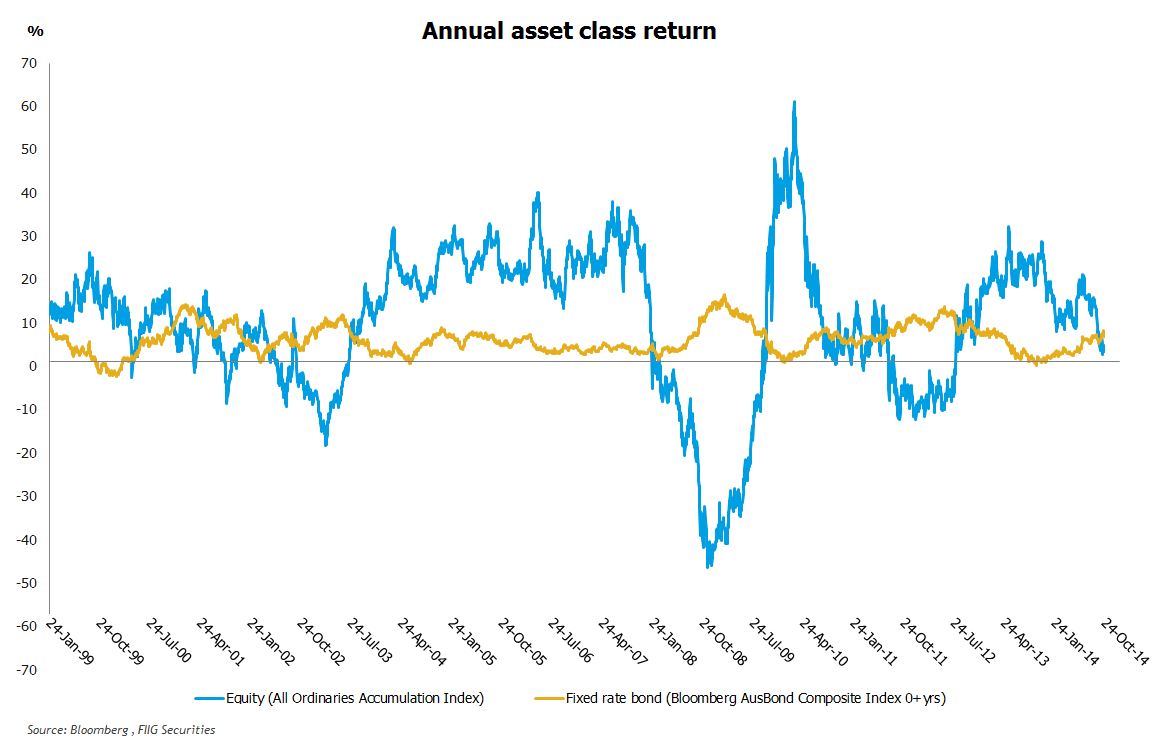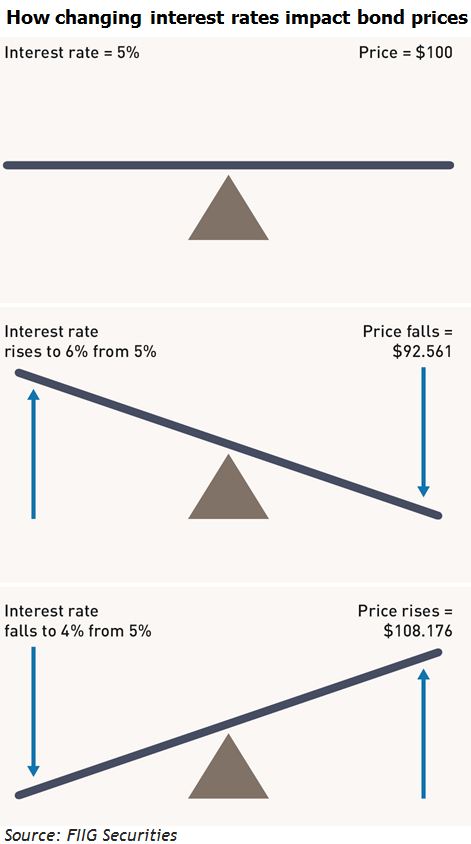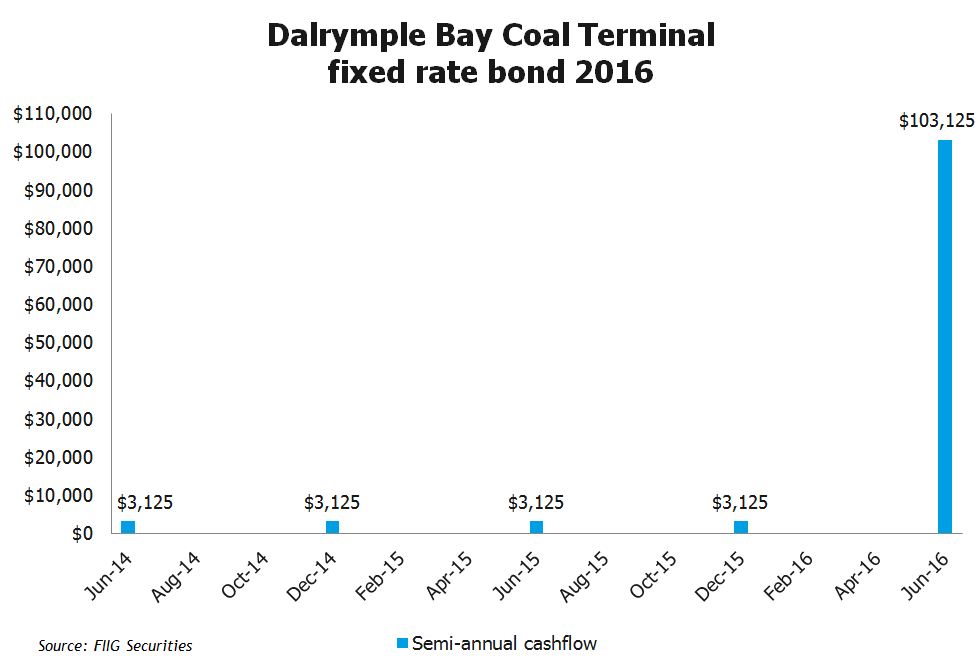by
Elizabeth Moran | May 27, 2014
Updated 17 February 2015
This is the first article in a three part series. Combined, the articles explain that bonds are appropriate investments across all economic cycles. There are three different bonds that work best under different economic conditions:
- Fixed rate
- Floating rate
- Inflation linked
It is important to hold an allocation to all three bonds for protection, as investors can never be sure that interest rates will not move higher or lower or inflation spirals. However, the portfolio weighting may change depending on the investor’s view of interest rates.
Ideally investors should read all three articles to understand the characteristics of the bonds and how they might work in an investment portfolio.
A fixed rate bond is a security that pays a fixed pre-determined rate of interest (known as a coupon). A fixed rate bond’s interest rate will be set at the time of issue and will not change during the life of the bond.
Fixed rate bonds add interest rate “risk” to your portfolio in that the only way these bonds can reflect changes in market expectations of interest rates is through a change in the price of the bond. If interest rates fall, fixed rate bond prices will rise. The opposite is also true, if interest rates rise, fixed rate bond prices will fall.
In the example below, assume an investor purchases a ten year fixed rate bond worth $100 at an interest rate of 5%. Fixed rate bonds will pay the same rate of interest for the life of the bond. If interest rates then rise to 6% from 5%, investors in the secondary market are not willing to outlay $100 to earn a 5% return. They demand a 6% return in line with market expectations. To achieve a 6% return the price of the bond must fall to $92.561 to satisfy the 6% required rate. Likewise if interest rates fall to 4% investors are willing to pay more for the bond and the bond price will rise to $108.176.
These bonds are particularly protective in an overall investment portfolio as they outperform in a contracting economic environment when you would expect declining share and property prices. That is, fixed rate bonds tend to be counter-cyclical. When the Reserve Bank is easing the cash rate (to try and stimulate the economy) fixed rate bond prices typically rise. So a fixed rate bond allocation will act to smooth overall portfolio returns, as shown in the graph below which compares the performance of the All Ordinaries Accumulation Index (the blue line) and the UBS Fixed Rate Bond Index (the grey line). Note the low points of the equity index versus the increase in return of the fixed rate bond index. Equities returns are more volatile, that is show greater variability in return.

The prices of fixed rate bonds can vary considerably. For example in 25 November 2010 Stockland issued a fixed rate bond with at an 8.25% fixed interest rate. Since then, the cash rate has declined and the bond’s price has risen to be $123.859 (pricing accurate at 17 February 2015). Investors who had bought the Stockland bond at first issue could sell the bond and take a higher than expected return or otherwise continue to hold the bond and enjoy the high income stream.
Bond prices can also fall below their $100 issue price, but investors know when they buy a bond, assuming the company continues to operate, if they hold that bond until maturity, they will receive $100 face value.
Fixed rate bonds can be attractive investments in a low interest environment. As returns are fixed, those bonds issued with high interest rates will pay a high, defined income stream which is attractive to income seeking investors.
The Commonwealth government, state governments, public and private corporations (both domestic and international) all issue fixed rate bonds in Australia.

An example of a fixed rate bond is the Dalrymple Bay Coal Terminal 6.25% bond maturing on 9 June 2016. Assuming a $100,000 face value investment, this bond pays a half yearly interest payment (like most fixed rate bonds) of $3,125. In the month that the bond matures, investors receive the $3,125 interest payment as well as the return of the $100,000 face value investment.

Copyright The contents of this document are copyright. Other than under the Copyright Act 1968 (Cth), no part of it may be reproduced or distributed to a third party without FIIG’s prior written permission other than to the recipient’s accountants, tax advisors and lawyers for the purpose of the recipient obtaining advice prior to making any investment decision. FIIG asserts all of its intellectual property rights in relation to this document and reserves its rights to prosecute for breaches of those rights.
Disclaimer Certain statements contained in the information may be statements of future expectations and other forward-looking statements. These statements involve subjective judgement and analysis and may be based on third party sources and are subject to significant known and unknown uncertainties, risks and contingencies outside the control of the company which may cause actual results to vary materially from those expressed or implied by these forward looking statements. Forward-looking statements contained in the information regarding past trends or activities should not be taken as a representation that such trends or activities will continue in the future. You should not place undue reliance on forward-looking statements, which speak only as of the date of this report. Opinions expressed are present opinions only and are subject to change without further notice.
No representation or warranty is given as to the accuracy or completeness of the information contained herein. There is no obligation to update, modify or amend the information or to otherwise notify the recipient if information, opinion, projection, forward-looking statement, forecast or estimate set forth herein, changes or subsequently becomes inaccurate.
FIIG shall not have any liability, contingent or otherwise, to any user of the information or to third parties, or any responsibility whatsoever, for the correctness, quality, accuracy, timeliness, pricing, reliability, performance or completeness of the information. In no event will FIIG be liable for any special, indirect, incidental or consequential damages which may be incurred or experienced on account of the user using information even if it has been advised of the possibility of such damages.
FIIG provides general financial product advice only. As a result, this document, and any information or advice, has been provided by FIIG without taking account of your objectives, financial situation and needs. Because of this, you should, before acting on any advice from FIIG, consider the appropriateness of the advice, having regard to your objectives, financial situation and needs. If this document, or any advice, relates to the acquisition, or possible acquisition, of a particular financial product, you should obtain a product disclosure statement relating to the product and consider the statement before making any decision about whether to acquire the product. Neither FIIG, nor any of its directors, authorised representatives, employees, or agents, makes any representation or warranty as to the reliability, accuracy, or completeness, of this document or any advice. Nor do they accept any liability or responsibility arising in any way (including negligence) for errors in, or omissions from, this document or advice. Any reference to credit ratings of companies, entities or financial products must only be relied upon by a ‘wholesale client’ as that term is defined in section 761G of the Corporations Act 2001 (Cth). FIIG strongly recommends that you seek independent accounting, financial, taxation, and legal advice, tailored to your specific objectives, financial situation or needs, prior to making any investment decision. FIIG does not make a market in the securities or products that may be referred to in this document. A copy of FIIG’s current Financial Services Guide is available at www.fiig.com.au/fsg.
An investment in notes or corporate bonds should not be compared to a bank deposit. Notes and corporate bonds have a greater risk of loss of some or all of an investor’s capital when compared to bank deposits. Past performance of any product described on any communication from FIIG is not a reliable indication of future performance. Forecasts contained in this document are predictive in character and based on assumptions such as a 2.5% p.a. assumed rate of inflation, foreign exchange rates or forward interest rate curves generally available at the time and no reliance should be placed on the accuracy of any forecast information. The actual results may differ substantially from the forecasts and are subject to change without further notice. FIIG is not licensed to provide foreign exchange hedging or deal in foreign exchange contracts services. The information in this document is strictly confidential. If you are not the intended recipient of the information contained in this document, you may not disclose or use the information in any way. No liability is accepted for any unauthorised use of the information contained in this document. FIIG is the owner of the copyright material in this document unless otherwise specified.
The FIIG research analyst certifies that any views expressed in this document accurately reflect their views about the companies and financial products referred to in this document and that their remuneration is not directly or indirectly related to the views of the research analyst. This document is not available for distribution outside Australia and New Zealand and may not be passed on to any third party without the prior written consent of FIIG. FIIG, its directors and employees and related parties may have an interest in the company and any securities issued by the company and earn fees or revenue in relation to dealing in those securities.